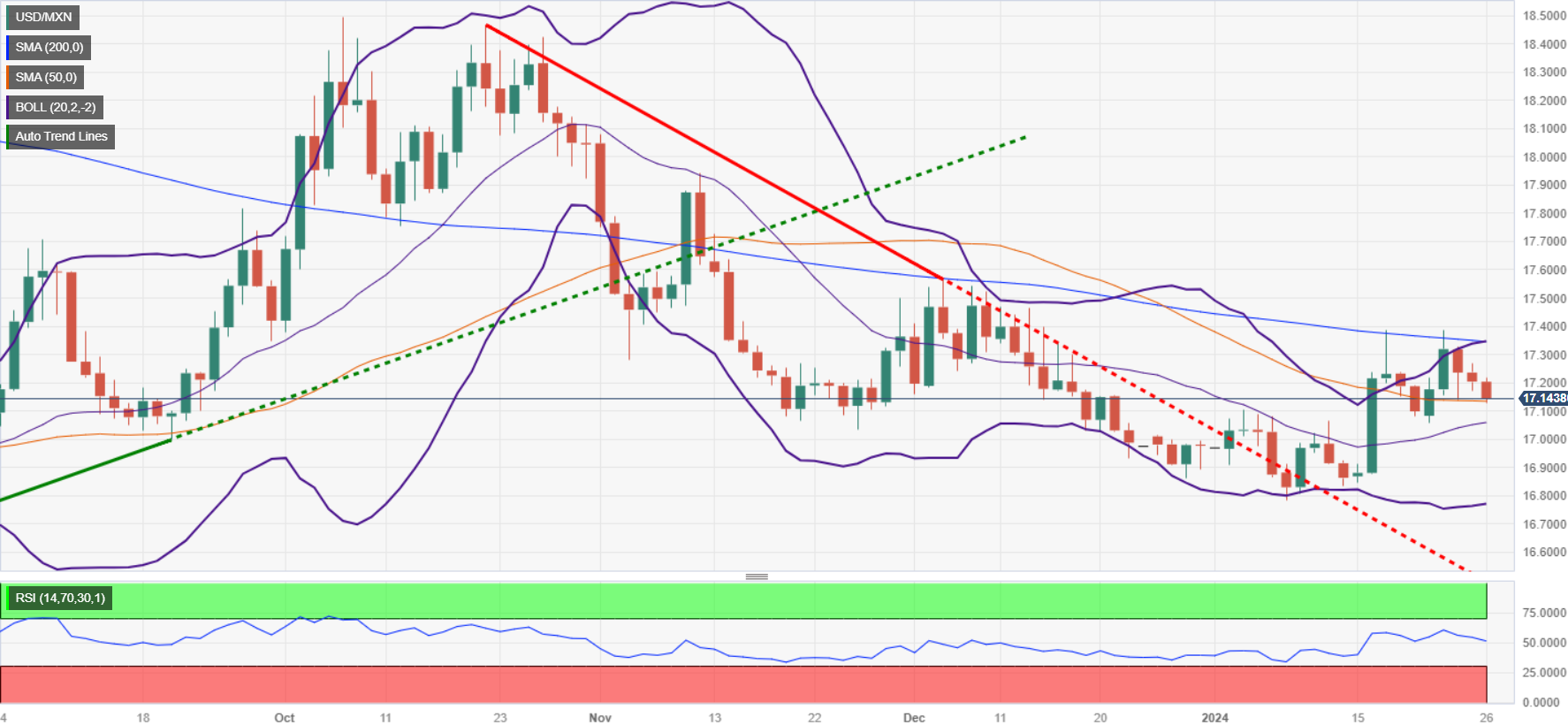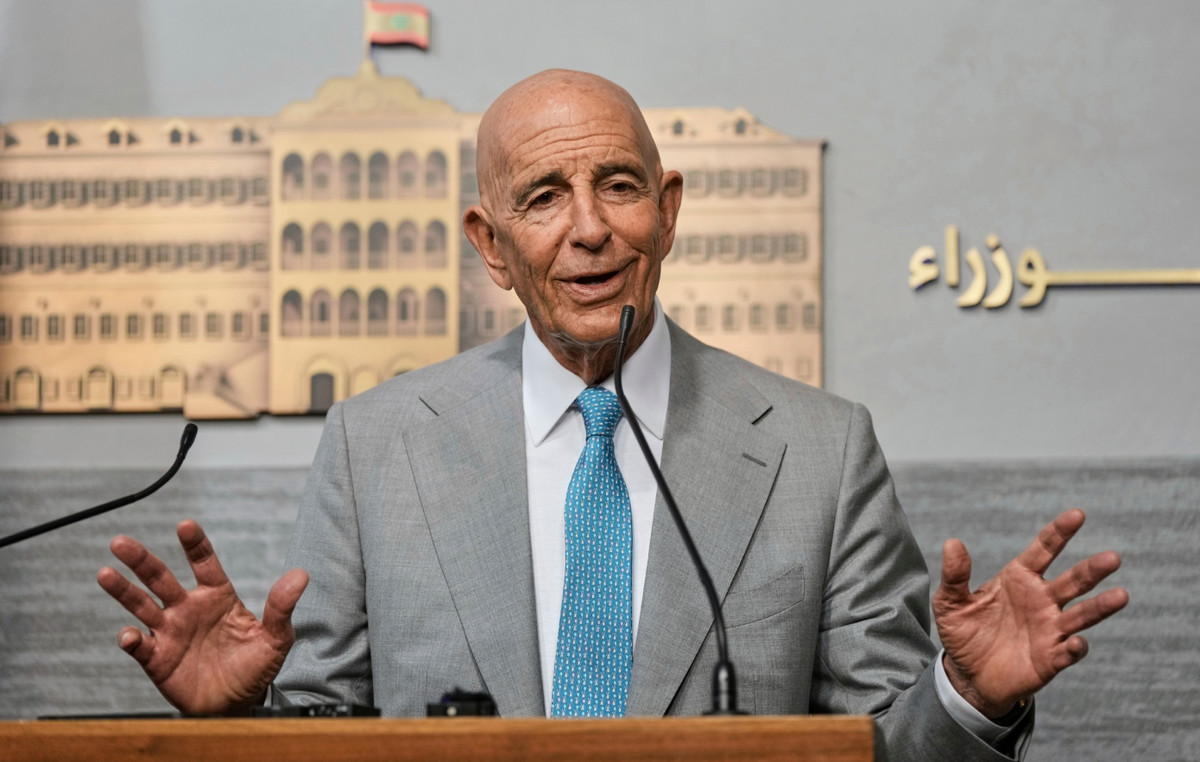- The Mexican peso strengthens for the third consecutive day, driven by the strength of the trade balance and the weakness of the US PCE.
- Mexico's sizeable December trade surplus and strong labor market underscore economic strength amid global uncertainty.
- The drop in the Fed's underlying PCE index below 3% fuels expectations of a rate cut in May, benefiting emerging currencies such as the MXN.
He Mexican peso (MXN) remains on a mission and rises for the third consecutive day against the United States Dollar (USD) after data from Mexico suggests that the trade balance expanded more than expected, while inflation data in the United States (US). USA) were softer. This has increased the odds of a rate cut by the United States Federal Reserve (Fed), keeping pressure on the Dollar (USD) as the interest rate differential would likely support the emerging market currency. The pair USD/MXN is trading at 17.17, losing 0.15% on the day.
Mexico's National Statistics Institute (INEGI) revealed that the country recorded a surplus in December. These data, together with those on the labor market published on Thursday, reflect the strength of the economy, reinforced by the prospects for relocation.
Meanwhile, the Fed's preferred inflation gauge, the personal consumption price index (PCE), remained unchanged, although the annualized core figure fell below the 3% threshold, a sign that restrictive policy is doing its job. cut prices. That said, investors seem convinced that the Fed will cut rates in May by 25 basis points (bps), according to the CME's FedWatch tool.
Daily summary of market movements: The Mexican peso continues to recover and cuts weekly losses
- Mexico's trade balance recorded a surplus in December of 4,242 million dollars, exceeding the previous reading and forecasts of 1,400 million dollars.
- Over the past week, Mexico's economic data witnessed mixed readings in the mid-month inflation report, with headlines beating forecasts and the core Consumer Price Index (CPI) slipping below the 5% threshold. . This could prevent the Bank of Mexico (Banxico) from cutting rates in the first quarter of 2024, despite the fact that two of its members expressed interest in December.
- Mexico's economic activity contracted in November, while annual figures fell from 4.2% to 2.3%, less than expected.
- The labor market in Mexico remains strong, as the unemployment rate fell from 2.7% to 2.6%.
- The economy in Mexico is beginning to show the impact of the high rates set by Banxico at 11.25%, despite the fact that most analysts estimate that the economy will grow above 2% in 2024. However, retail sales below According to estimates, the economy growing below 3% in November and inflation reaccelerating put a stagflation scenario in play.
- On January 5, a Reuters poll suggested that the Mexican peso could weaken by 5.4%, to 18.00 per dollar, in the 12 months following December.
- Across the border on Friday, the US CPI rose 2.6% in the 12 months through December, unchanged and as expected, while the core PCE fell from 3.2% to 2.9% and below forecasts.
- The latest data from the United States suggests that the economy remains robust and resilient, after growing 3.3% in the fourth quarter of 2023, exceeding estimates of 2%, and expanding 2.5% for the year as a whole.
- However, mixed readings from other data suggest that risks have balanced out. This is reflected by investors who speculate that the Fed will cut rates by 139 basis points during 2024, according to data from the Chicago Board of Trade (CBOT).
- The US Department of Commerce announced that durable goods orders in December remained stagnant, registering a variation of 0%. This is a notable decrease from the 5.5% increase recorded in November, mainly due to the recession in transportation equipment manufacturing.
- The U.S. Bureau of Labor Statistics reported that initial jobless claims for the week ending January 20 rose to 214,000, surpassing both the previous week's numbers and the 200,000 expected.
Technical Analysis: Mexican Peso Gains Traction as USD/MXN Falls Below 17.15
USD/MXN has accelerated lower after printing losses for three consecutive days, but continues to trade hands above the strong support of the 50-day SMA at 17.13. A break of the latter would expose the January 22 low, followed by the psychological figure of 17.00.
On the opposite side, if buyers reclaim the next resistance level at the 200-day SMA at 17.34, this could open the door to challenge the 100-day SMA at 17.41. Further upside is seen above the psychological figure of 17.50, ahead of the recovery from last year's May 23 highs at 17.99.
USD/MXN Price Action – Daily Chart

Frequently Asked Questions about the Mexican Peso
What is MXN?
The Mexican Peso is the legal tender of Mexico. The MXN is the most traded currency in Latin America and the third most traded on the American continent. The Mexican Peso is the first currency in the world to use the $ sign, prior to the later use of the Dollar. The Mexican Peso or MXN is divided into 100 cents.
What is Banxico and how does it influence the MXN?
Banxico is the Bank of Mexico, the country's central bank. Created in 1925, it provides the national currency, the MXN, and its priority objective is to preserve its value over time. In addition, the Bank of Mexico manages the country's international reserves, acts as a lender of last resort to the banks and advises the government economically and financially. Banxico uses the tools and techniques of monetary policy to meet its objective.
How does inflation impact the MXN?
When inflation is high, the value of the Mexican Peso (MXN) tends to decrease. This implies an increase in the cost of living for Mexicans that affects their ability to invest and save. At a general level, inflation affects the Mexican economy because Mexico imports a significant amount of final consumption products, such as gas, fuel, food, clothing, etc., and a large amount of production inputs. On the other hand, the higher the inflation and debt, the less attractive the country is for investors.
How does the Dollar influence the Mexican Peso (MXN)?
The exchange rate between the USD and the MXN affects imports and exports between the United States and Mexico, and may affect demand and trade flows. The price of the Dollar against the Mexican Peso is affected by factors such as monetary policy, interest rates, the consumer price index, economic growth and some geopolitical decisions.
How does the Fed's monetary policy affect Mexico?
The exchange rate between the USD and the MXN affects imports and exports between the United States and Mexico, and may affect demand and trade flows. The price of the Dollar against the Mexican Peso is affected by factors such as monetary policy, interest rates, the consumer price index, economic growth and some geopolitical decisions.
Source: Fx Street
I am Joshua Winder, a senior-level journalist and editor at World Stock Market. I specialize in covering news related to the stock market and economic trends. With more than 8 years of experience in this field, I have become an expert in financial reporting.







